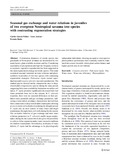Mostrar el registro sencillo del ítem
Seasonal gas exchange and water relations in juveniles of two evergreen neotropical savanna tree species with contrasting regeneration strategies
| dc.rights.license | http://creativecommons.org/licenses/by-nc-sa/3.0/ve/ | |
| dc.contributor.author | García Nuñez, Carlos | |
| dc.contributor.author | Azócar, Aura | |
| dc.contributor.author | Rada R., Fermin J. | |
| dc.date.accessioned | 2014-11-03T20:02:24Z | |
| dc.date.available | 2014-11-03T20:02:24Z | |
| dc.date.issued | 2011 | |
| dc.identifier.uri | http://www.saber.ula.ve/handle/123456789/39244 | |
| dc.description.abstract | Colonization dynamics of woody species into grasslands in Neotropical savannas are determined by two main factors: plant-available moisture and fire. Considering seasonality of precipitation and high fire frequency in these ecosystems, vegetative reproduction has been suggested as the main regeneration strategy in woody species. This study examined seasonal variations in water relations and photosynthesis in juveniles of two tree species with contrasting regeneration strategies: Palicourea rigida (sexual reproduction)and Casearia sylvestris (asexual reproduction). The studied species showed similar transpiration rates to deeprooted adult evergreen tree species during the rainy period,suggesting little water availability limitations on surface soil layers. P. rigida juveniles significantly decreased their leaf water potentials from wet to dry seasons. In C. sylvestris resprouts, there were no seasonal differences in their predawn water potentials and gas exchange parameters, indicating a water deficit avoidance characteristic derived from their connections to deep-rooted adult counterparts allowing access to moist soil at depth even during the drought period. P. rigida rely on strict control of water losses and turgor maintenance through elastic cell walls during the dry season.The iso-hydric behavior of gas exchange and most water relations parameters in C. sylvestris enable turgor maintenance during the dry season which also gives the possibility to achieve foliar expansion under water-stressed conditions for shallow-rooted plants. Nevertheless, in absence of water deficits, P. rigida had the advantage to be physiologically independent individuals, showing an equal or even superior photosynthetic performance that eventually could be translated into a more favorable whole-plant carbon balance and higher growth rates in wet habitats. | es_VE |
| dc.language.iso | en | es_VE |
| dc.publisher | Trees 25(3): 473-483 | es_VE |
| dc.rights | info:eu-repo/semantics/openAccess | |
| dc.subject | Casearia sylvestris | es_VE |
| dc.subject | Palicourea rigida | es_VE |
| dc.subject | Fire | es_VE |
| dc.subject | Water stress | es_VE |
| dc.subject | Water use efficiency | es_VE |
| dc.subject | Photosynthesis | es_VE |
| dc.title | Seasonal gas exchange and water relations in juveniles of two evergreen neotropical savanna tree species with contrasting regeneration strategies | es_VE |
| dc.type | info:eu-repo/semantics/article | |
| dc.description.colacion | 473-483 | es_VE |
| dc.description.email | cgarcia@ula.ve | es_VE |
| dc.description.email | aazocar@ula.ve | es_VE |
| dc.description.email | frada@ula.ve | es_VE |
| dc.publisher.pais | Venezuela | es_VE |
| dc.subject.facultad | Facultad de Ciencias | es_VE |
| dc.subject.institucion | Universidad de Los Andes | es_VE |
| dc.subject.thematiccategory | Biología | es_VE |
| dc.subject.tipo | Artículos | es_VE |
| dc.subject.unidadinv | Instituto de Ciencias Ambientales y Ecológicas (ICAE) | es_VE |
| dc.type.media | Texto | es_VE |
Ficheros en el ítem
Este ítem aparece en la(s) siguiente(s) colección(ones)
-
Articulos, Pre-prints (Facultad de Ciencias)
-
Articulos, Pre-prints (Instituto de Ciencias Ambientales y Ecológicas (ICAE))
Articulos, Pre-prints del Instituto de Ciencias Ambientales y Ecológicas (ICAE)


